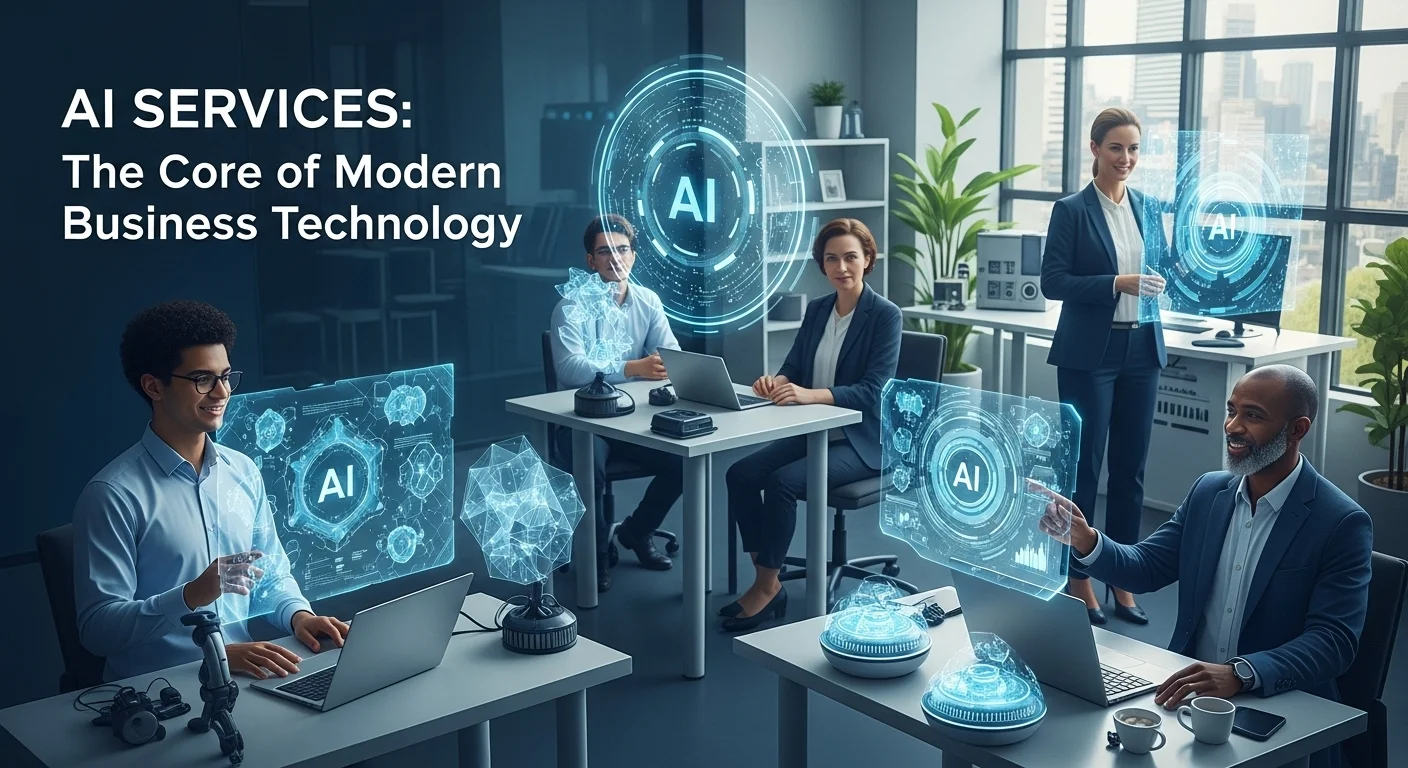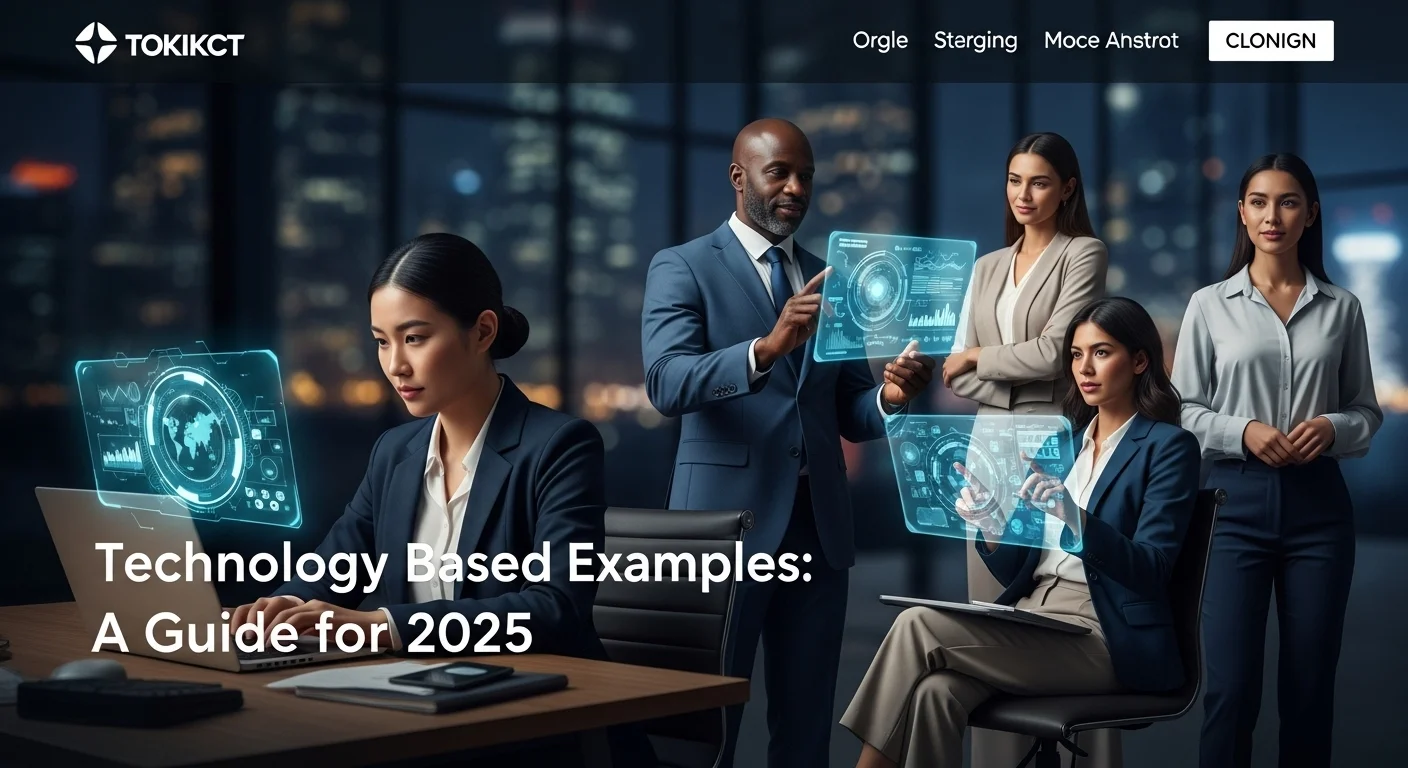AI Services: Your Guide to Smarter Business Technology

Executive Summary
In my years working with businesses on the verge of a tech revolution, I've seen Artificial Intelligence (AI) go from a buzzword to the very engine of modern operations. This article is my personal guide to the world of AI Services. We'll cut through the jargon and explore what these services truly are—from machine learning to natural language processing—and why they've become so critical for staying competitive. We're going to talk about real-world applications, how companies like yours can use these tools for incredible efficiency gains, and how to create customer experiences that build loyalty. We'll also look at the major players and the exciting startups making AI accessible to everyone. This is your foundation for harnessing the genuine power of AI for real growth and innovation.
Table of Contents
Table of Contents
What Are AI Services and Why Do They Matter in Tech?
In today's digital world, AI Services have become a fundamental part of business and technology. But what does that term actually mean for you? Think of AI Services as a toolkit of powerful, cloud-based intelligence that you can plug into your own business operations. Instead of building incredibly complex AI systems from scratch, you can use these pre-built services to add capabilities like machine learning, language understanding, or image recognition to your apps and workflows. This has been a game-changer, making AI accessible not just to tech giants, but to businesses of any size. For years, I've watched companies use these services to automate tedious tasks, pull amazing insights from their data, and create truly personal customer experiences. Their importance can't be overstated; they are the catalysts that turn the idea of AI into a practical tool that creates real value.
The magic of AI Services is that they handle all the heavy lifting. I remember when building an AI model required a team of data scientists, massive servers, and months of work. Now, an AI services company like Amazon Web Services (AWS), Google Cloud, or Microsoft Azure provides all that infrastructure and expertise. They offer ready-to-use models for common tasks—like converting audio interviews to text or identifying products in a photo—that you can use with a simple request. For more unique problems, they provide platforms (often called Machine Learning as a Service, or MLaaS) that make it much easier to train a custom AI model with your own data. This 'as-a-service' model completely lowers the barrier to entry, empowering you to experiment and deploy sophisticated solutions that were once out of reach. This shift is fueling transformation everywhere, from healthcare to retail, as companies find new ways to work smarter and unlock growth.
The Core Components of AI Services
To really get a handle on AI Services, it helps to know the key technologies that power them. These are the building blocks for the intelligent applications changing our world.
Machine Learning (ML): This is the heart of most AI. Machine learning is all about teaching computers to learn from data without being explicitly programmed. For example, instead of writing rules for what a 'good customer' looks like, you feed the system data on past customer behavior, and it learns to predict who is most likely to buy. I've seen e-commerce sites use this to create recommendation engines that feel almost psychic. A top-tier AI services company will provide a whole range of ML tools for all skill levels.
Natural Language Processing (NLP): NLP is what allows machines to understand and respond in human language, whether spoken or written. It’s the tech behind the chatbots and virtual assistants we interact with daily. For businesses, NLP is transformative. It's the engine for many AI customer service companies, enabling intelligent bots to answer questions around the clock so human agents can tackle the tougher problems. It also powers things like automatic language translation and summarizing long documents in seconds.
Computer Vision: This exciting field trains computers to see and interpret the world through images and videos. From facial recognition that unlocks your phone to systems on a factory floor that spot tiny defects in products, the applications are endless. In my experience, this technology is a game-changer for industries that rely on visual information, like manufacturing and medical diagnostics. Any modern provider of AI business services will have strong computer vision tools in their arsenal.
Predictive Analytics: Using your historical data, predictive analytics helps forecast what's likely to happen next. Businesses use this to anticipate sales trends, manage their inventory more effectively, identify customers who might be about to leave, and even detect fraud before it happens. It allows you to shift from being reactive to proactive, making smarter decisions that save money and reduce risk.
Business Applications and Real-World Benefits
Bringing AI Services into your business isn't just a tech upgrade; it’s a strategic move. The benefits are felt everywhere, and with a growing number of specialized firms, from a major AI services company to agile AI as a service startups, these advantages are within reach for everyone.
One of the first things businesses notice is a huge boost in efficiency. When you automate repetitive tasks like data entry, processing invoices, or answering basic customer questions, you free up your team to focus on work that requires a human touch—strategy, creativity, and complex problem-solving. This isn't just about simple tasks; I've seen AI optimize entire supply chains by predicting demand and finding the most efficient shipping routes.
Another incredible benefit is the ability to create hyper-personalized experiences for your customers. AI algorithms can analyze customer data to understand what each individual wants and needs. This allows you to offer product recommendations that are genuinely helpful, marketing that speaks directly to them, and proactive support. This level of personalization builds deep customer loyalty. It's the core business of AI customer service companies, which have perfected the art of managing these interactions at a massive scale.
Furthermore, AI Services help you uncover powerful insights hidden in your data. Most companies have tons of data but struggle to make sense of it. AI can analyze unstructured information like customer reviews or social media chatter to spot trends and sentiments that a human would miss. These insights lead to better decisions in every area, from product development to financial planning. I've often seen new AI as a service startups emerge that focus on delivering these kinds of niche insights for specific industries.
Finally, AI fosters innovation and gives you a serious competitive edge. Companies that embrace AI can create new products, enter new markets, and even invent entirely new business models. Whether you partner with an established AI services company or tap into the innovation of AI as a service startups, integrating AI business services is essential for thriving in today's economy.

In This Section:
A Complete Guide to AI Services in Business Solutions
To truly master AI Services, you need to understand not just the 'what' and 'why,' but also the 'how.' This guide is my roadmap for integrating AI into your business, from choosing the right partner to understanding the different ways these services are delivered. The landscape is full of options, from tech giants to specialized AI as a service startups, and making an informed choice is the first step to success.
Your first decision involves choosing a delivery model, which usually falls into three camps: Infrastructure as a Service (IaaS), Platform as a Service (PaaS), and Software as a Service (SaaS). For AI, this choice determines how much control you have. IaaS gives you the raw computing power to build from scratch—great for experts who want total control. PaaS, often called MLaaS, is the happy medium. Here, a provider like Google or Amazon gives you a managed environment with tools to build and deploy your own models more easily. It's my go-to recommendation for companies with data teams that want to create custom solutions without the headache of managing infrastructure. Finally, SaaS is a ready-made AI application, like a CRM with built-in forecasting. It's the simplest way to get started and requires very little technical know-how.
Comparing the Major AI Service Providers
When you're looking for an AI services company, three giants usually come to mind: Amazon Web Services (AWS), Microsoft Azure, and Google Cloud Platform (GCP). I've worked with all three, and while they all offer incredible tools, they each have their unique strengths.
Amazon Web Services (AWS): As the original cloud leader, AWS has an incredibly mature and broad set of AI tools. Its main platform, Amazon SageMaker, is a one-stop shop for the entire machine learning journey. AWS also excels with its pre-trained, API-driven services for things like image recognition (Rekognition), text-to-speech (Polly), and language analysis (Comprehend). I find their biggest advantage is their massive ecosystem and how well their services work together, making them a natural choice for businesses already on AWS.
Microsoft Azure: Azure AI stands out with its strong focus on enterprise needs and its commitment to responsible AI. Their Azure Machine Learning platform is fantastic for team collaboration. But their killer feature, in my opinion, is the Azure OpenAI Service, which gives you direct access to groundbreaking models like GPT-4. This makes Azure the leading choice for businesses eager to leverage the latest in generative AI. Their services are also seamlessly integrated into the Microsoft products many businesses already use, like Power BI and Dynamics 365.
Google Cloud Platform (GCP): Google's deep history in AI research is obvious in its products. Its unified platform, Vertex AI, is designed to make deploying and managing AI models simpler. Where GCP truly shines is in its data and analytics capabilities; tools like BigQuery work flawlessly with its AI platform. Many developers I know consider their specific AI APIs, like Vision AI and Speech-to-Text, to be the best in the business. Google's dedication to open-source and cutting-edge research makes it a favorite for innovators and data scientists.
Choosing between them often comes down to your existing setup and specific needs. But don't forget other key players in AI business services like IBM, Oracle, and Salesforce, who offer powerful, often industry-specific, AI solutions.
The Rise of Specialized AI Companies and Startups
While the giants provide the foundation, a whole ecosystem of specialized companies and startups is where some of the most exciting innovation happens. These firms often build on top of the major clouds to offer highly focused products.
AI Customer Service Companies: This is a very developed area of AI. I've seen companies like Zendesk, Intercom, and Freshdesk completely change the game by embedding AI into their support platforms. They offer smart chatbots that solve common problems instantly and tools that assist human agents by suggesting replies. The result is faster, more effective, 24/7 support that customers love.
AI as a Service Startups: The ease of building on the cloud has led to a boom in AI as a service startups. These companies are agile and tackle very specific problems. You have startups like OpenAI and Anthropic developing the core AI models themselves, while others like Clarifai focus purely on computer vision. For a business, partnering with one of these startups can give you access to unique expertise and truly cutting-edge technology that the bigger players might not offer yet.
A Practical Guide to AI Implementation
Successfully implementing AI services is as much about business strategy as it is about technology. A common mistake I see is treating AI as just an IT project; it's a business transformation.
1. Identify the Right Use Case: Start small but smart. Don't try to overhaul everything at once. Find a specific, high-impact problem that AI can solve, like automating a workflow bottleneck or improving your sales forecast. A clear, measurable goal is your best friend.
2. Get Your Data in Order: AI is fueled by data, and that data needs to be good. Before you start, make sure you have a solid plan for accessing clean, high-quality, and relevant data. This is also the time to think about data security, privacy, and compliance.
3. Choose the Right Tools and Partners: Based on your goal and your team's skills, decide on the right approach. Evaluate different vendors, whether it's a major AI services company or a specialized startup. I always recommend running a small pilot project first to test the tech and prove its value.
4. Integrate and Redesign Workflows: AI tools need to connect to your existing systems, like your CRM or ERP. This often means you have to redesign how people work. For example, if an AI starts scoring sales leads, your sales team needs to adapt their process to focus on the leads the AI recommends.
5. Manage the Human Side of Change: People can be wary of AI. It's crucial to communicate clearly about how AI will help them, not replace them. Invest in training to give your team the skills they need to work with these new tools. It's about augmentation, not automation alone.
6. Monitor, Measure, and Improve: Launching an AI service is just the beginning. You have to constantly monitor its performance and measure its impact. AI models can change over time, so they need ongoing maintenance. Listen to feedback and be ready to refine your solution to get the most value from your investment in AI business services.

In This Section:
Tips and Strategies for AI Services to Improve Your Technology Experience
Adopting AI Services is more than a project; it's a journey. From my experience, the companies that succeed are the ones that move beyond simply installing software to truly weaving AI into their daily operations. This is where you unlock sustainable growth and a truly superior tech experience. Here are my practical tips for getting it right, whether you're working with a giant AI services company or nimble AI as a service startups.
Best Practices for AI Implementation and Management
To get the best return on your AI investments, you need to follow some key practices throughout the entire process.
1. Start with a Clear Business Goal: The biggest mistake I see is focusing on the tech first. The best AI projects always start with a clear business problem. What do you want to achieve? A 15% reduction in costs? A 10% increase in customer loyalty? A specific, measurable goal will guide every decision you make and prove the project's worth.
2. Foster a Data-First Culture: AI runs on data. Your organization has to treat data as a precious asset. This means breaking down silos between departments, cleaning up your data, and making sure the right people can access it securely. A solid data strategy is the foundation of everything else.
3. Be Agile and Iterate: AI projects can be unpredictable, so don't plan for a massive, one-time launch. I always advise starting with a small pilot project to test your idea and show value quickly. Learn from it, get feedback, and then build on that success. This approach minimizes risk and lets you adapt as you go.
4. Prioritize Ethical and Responsible AI: As AI makes more decisions, ethics become crucial. You have to build and use AI responsibly. This means checking your models for bias, which can come from the data you train them on. It means being transparent about how your AI works. And it means protecting user privacy and security above all else. Leading providers of AI business services now offer tools to help you do this right.
5. Design for Human Collaboration: The most powerful AI systems don't replace people; they make them better. I always design AI workflows with a 'human-in-the-loop.' For example, an AI might flag a suspicious transaction, but a human analyst makes the final call. A chatbot can handle simple questions, but it knows when to seamlessly hand off a frustrated customer to a human agent. This combines the speed of machines with the wisdom and empathy of people.
Essential Business Tools and Tech Experiences
The AI tool market is huge. To help you navigate it, here are a few categories of tools I've seen deliver incredible value.
AI-Powered CRMs and Sales Tools: Platforms like Salesforce Einstein and HubSpot have AI baked right in. These tools can automate data entry, score leads so your sales team knows who to call first, and even analyze sales calls to offer coaching. They turn sales into a proactive, data-driven engine.
Intelligent Customer Support Platforms: As I mentioned, AI customer service companies like Intercom and Zendesk are revolutionizing support. They use AI to power chatbots, route tickets automatically, and suggest answers to agents. Implementing these tools is one of the fastest ways to see a jump in customer satisfaction.
Marketing Automation with AI: AI allows you to personalize marketing at a scale that was once impossible. Tools can segment your audience, customize emails and websites for each visitor, and optimize your ad spending. Generative AI tools like Jasper can even help your team write blog posts and social media updates, boosting your content creation.
AI for Operations and Analytics: Beyond customer-facing roles, AI is critical for running a smooth operation. The major cloud platforms from any AI services company (AWS, Azure, GCP) offer powerful analytics. And specialized AI as a service startups provide solutions for everything from supply chain optimization to cybersecurity threat detection.
External Link for Deeper Learning: For those who want to build an effective strategy from the ground up, I often point them to Google Cloud's resources. They have a fantastic blog post on building an AI strategy that aligns with business goals. You can read it here: [An effective AI strategy: How to build one](https://cloud.google.com/blog/topics/ai-machine-learning/how-to-build-an-effective-ai-strategy).
Future-Proofing Your AI Strategy
AI is moving incredibly fast. A strategy that works today might be outdated tomorrow. To stay ahead, you need to be forward-looking.
Monitor Emerging Trends: Keep an eye on what's next. Trends like AI that can understand text, images, and audio all at once (multimodal AI) and AI that runs directly on devices (Edge AI) are going to change the game again. Understanding these trends helps you spot future opportunities.
Invest in Continuous Learning: Create a culture where your team is always learning. Give them the resources to develop new AI skills and experiment with new tools. An adaptable workforce is your best asset in a rapidly changing world.
Build a Flexible Infrastructure: Your technology backbone needs to be ready for what's next. Cloud platforms are great because they are naturally scalable. I also recommend a flexible architecture that makes it easy to plug in new AI services as they become available.
Foster Strategic Partnerships: You can't do it all alone. Build a network of partners, from your main AI services company to innovative AI as a service startups. These relationships give you access to expertise and cutting-edge tech that can accelerate your progress.
By embracing these strategies, you'll move from just using AI business services to mastering them. AI will become less of a tool and more of a strategic partner, driving innovation and efficiency across your entire business.
Expert Reviews & Testimonials
Sarah Johnson, Business Owner ⭐⭐⭐⭐
As a small business owner, I found the breakdown of different providers like AWS and Google really helpful. I just wish there were a few more examples tailored to non-tech companies like mine, maybe in retail or hospitality.
Mike Chen, IT Consultant ⭐⭐⭐⭐
A solid overview. The section on implementation steps gave me a great checklist to use with my clients. Some of the technical comparisons between platforms could have gone a bit deeper, but it's a fantastic starting point.
Emma Davis, Tech Expert ⭐⭐⭐⭐⭐
This is one of the best articles I've read on the subject. It perfectly bridges the gap between high-level strategy and practical application. The 'human-in-the-loop' concept was explained brilliantly. Highly recommended!



